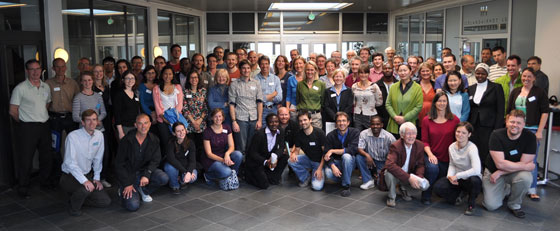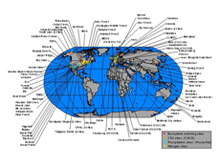
CLIMMANI/INTERFACE joint workshop:
Nutrient constraints on the net carbon balance
June 15-17, 2011
Keflavik, Iceland
The INTERFACE and CLIMMANI networks bring together researchers working on climate change effects in terrestrial ecosystems in order to facilitate interaction, syntheses of results and collaboration. In particular, bringing experimentalists and ecosystem and Earth system modelers together has a special priority.
This workshop explored 6 topics that we believe are keys to understanding how the net carbon balance is controlled by nutrient interactions. Each session synthesized and discussed the state of knowledge within one of these areas and identified gaps in knowledge and abilities to model it at a local and global scale. Each session lasted 2½ hours. The overarching goal of the workshop was to catalyze discussions and future activities that improve the realism of Earth system models.
Local organizers were Bjarni D. Sigurdsson and Helena M. Stefansdottir from the Agricultural University of Iceland.
| Scientific organizing committee |
Claus Beier Bridget Emmett bae@ceh.ac.uk |
Jeff Dukes jsdukes@purdue.edu Peter Thornton thorntonpe@ornl.gov |
|
| Session | Topic | Question | Session Chairs |
| Session 1 Wed. 15th June 9.00-11.30 |
Carbon availability as a control on carbon sequestration | To what extent is carbon uptake in plants controlled by CO2 availability or by plant demand – is atmospheric CO2 concentration or the carbon consumption by growth driving sequestration, and is this correctly described in plot scale and Earth system models? |
Christian Körner Steve Running Hendrik Poorter: Is plant growth driven by photosynthesis? Christian Körner: Concepts and constraints for scaling from baseline metabolism to ecosystem carbon relations Reto Stockli: Integrating the terrestrial water and carbon cycles in Earth Systems Steve Running: Global scale calculations of the terrestrial carbon and water cycle components with remote sensing. |
| Session 2 Wed. 15th June 13.00-15.30 |
Nitrogen limitation and nitrogen fixation | Nitrogen is one of the prime limiting factors for carbon sequestration. Consequently, the input of N to a given site is important for understanding future responses of carbon sequestration. One of the main unknown input fluxes is nitrogen fixation, which is associated with both methodological problems as well as lack of process understanding. |
Tom DeLuca Elena Shevliakova Dr. Stefan Gerber: Global dynamic land modelling of C & N cycling. Dr. Lianhai Wu: Ecosystem scale modelling of C and N flux incorporating leguminous N fixation in agricultural systems. Dr. Sasha Reed: Topic area: Controls on N fixation in tropical ecosystems. Michael Gundale: Nitrogen fixation in moss communities in boreal forests and broader influence on ecosystem N cycle. |
| Session 3 Wed. 15th June 16.00-18.30 |
Phosphorus limitations to plant growth and microbial processes | Nitrogen receives attention as a primary constraint on carbon sequestration in terrestrial ecosystems. However, it is generally accepted that phosphorus may play an increasing role in many ecosystems. This needs to be experimentally investigated and documented, as P cycling may need to be included in modeling frameworks. |
Cory Cleveland Lina Mercado Ben Turner: Nutrient limitation of above and below-ground productivity in lowland and montane tropical rain forest Ben Houlton: A framework for representing P in earth system models Lina Mercado: Accounting for N &P limitations in tropical forests using the land component of an earth system model |
| Session 4 Thurs. 16th June 9.00-11.30 |
Acidity and base cation availability as a controlling factor on soil carbon sequestration | Recent findings indicate that soil acidity may strongly influence soil carbon sequestration and decomposition processes. This also has strong interactions with base cation status and macronutrient availability. How well do we understand these processes and are they included in our present models? |
Filip Oulehle Christy Goodale Filip Ouhle: Major changes in forest carbon and nitrogen cycling caused by declining sulphur deposition. Frank Berninger: Long term changes in tree productivity as a response to acid and nitrogenous deposition, evidence from tree rings and isotopes.Vince Gauci: Sulfur deposition and methane emissions from wetland soils April Melvin: Calcium fertilization alters forest carbon storage |
| Session 5 Thurs. 16th June 13.00-15.30 |
Ecological adaptation and its impacts, interactions and controls on resource availability | Resource availability and limitations may have a direct impact on carbon sequestration processes, but also affect ecological processes and plant species composition, which feed back to resource availability. How well do we understand these processes and their indirect control on resource availability, and can we model them? |
Sarah Hobbie Ben Smith Rüdiger Grote: Resource-use description in physiologically-based models – A major restriction for describing competition? Will Cornwel: Limits to positive feedbacks: a more complete model for community assembly and species' effects on decomposition. Rosie Fisher: The representation of space and stochasticity in one-dimensional and deterministic global vegetation models |
| Session 6 Thurs. 16th June 16.00-18.30 |
Nitrogen limitation as a controlling factor for soil carbon dynamics | Nitrogen is often considered to be the prime and general limiting factor for carbon sequestration in terrestrial ecosystems. There is increasing debate on the role of N in controlling soil carbon dynamics. |
Ivan Janssens Marc Post Ivan Janssens: N deposition and fertilization reduce soil respiration: Evidence and mechanisms. Peter van Bodegom: Towards global quantification of soil N-C-cycles by coupling trait-based vegetation models to microbial biomass induced soil mineralization models Pam Templer: Impact of nitrogen deposition on carbon storage in terrestrial ecosystems |
| Poster Session Thurs. 16th June 19.00-21.00 |
Claus Beier Jeff Dukes
|
||
| Discussion Thurs. 16th June 9.00-11.30 |
Jeff Dukes Claus Beier |
||
| 13th June | 14th June | 15th June | 16th June | 17th June | |
| 9.00-11.30 | Iceland Excursion | Session 1 | Session 4 | General discussion and wrap up | |
| 13.00-15.30 | Iceland Excursion | Session 2 | Session 5 | Lunch and/or departure | |
| 16.00-18.30 | Arrival for some |
Arrival for some Iceland Excursion |
Session 3 | Session 6 | |
| Dinner and icebreaker | Conference dinner | Poster session and snack - dinner |









